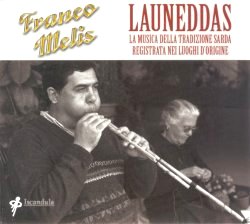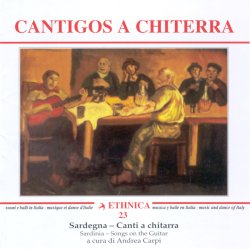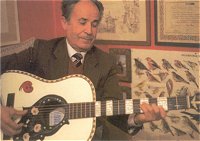| Franco Melis
|
| Launeddas
|
| Iscandula ISCA 0002
|
| Cantigos a chiterra
|
| Various performers
|
| Taranta Ethnica TA22
|
This review is of two Felmay-distributed CDs of music from Sardinia - and both are slightly unusual. The first is by a fairly young player (45 years of age) who, nonetheless, plays in the old 'classic' launeddas style and eschews any attempt at improvisation. The second is of the Sard 'guitar song' repertoire - CDs of which (at least, in this office) are rarely seen.
Franco Melis comes from roughly the same area (near Cagliari in the south of the island) from which the 1930s launeddas maestro Efisio Melis hailed, but there is no mention in the booklet of them being related.  As I have noted before, Sardinia seems to have a good number of very common surnames, so this should not surprise us. He learned his trade, as have most launeddas players, by apprenticeship to an established master - in his case, to Aureliu Porcu. Porcu, in his turn, had been apprenticed to Antonio Lara - the other great maestro of the Thirties, and Efisio Melis' main rival!
As I have noted before, Sardinia seems to have a good number of very common surnames, so this should not surprise us. He learned his trade, as have most launeddas players, by apprenticeship to an established master - in his case, to Aureliu Porcu. Porcu, in his turn, had been apprenticed to Antonio Lara - the other great maestro of the Thirties, and Efisio Melis' main rival!
It was the practice - in the 'golden age' of the launeddas - for a pupil who excelled to experiment and develop a new style of playing which, when he in his turn took on apprentices, became a new 'school' of the tradition. Franco Melis is said to be exceptional in that, while being acclaimed as a modern maestro, he has avoided experimentation of any kind. The booklet notes tell us that: 'The tradition is honoured in everything he does. In his generation, he stands out as one of the most fastidious interpreters of the 'classical' styles favoured by the professionals of the previous era.'
The traditional apprenticeship required not only a mastery of playing the instrument, but also of its manufacture. Again the notes say that 'Today, his instruments are considered among the best to be had, and many players, the famous included, carry his instruments with pride in their stracasciu - the leather case in which [they] might keep 20 instruments.' This probably needs a little explanation ...
The launeddas is an instrument consisting of 3 reed pipes - one drone and two chanters of different lengths. All three are blown simultaneously and the player uses 'circular breathing' to maintain a continuous sound. So it sounds like a bagpipe - but the player's mouth acts as the bag. It's an exceptionally old instrument - a bronze statuette of a launeddas player was found in one of the many Nurages (dry-stone forts) in central Sardinia, and has been dated to the 9th century BC - 3,000 years ago! Each chanter has 5 holes, and is fingered principally, but not exclusively, by one hand (as you can see from the cover photo). By using different combinations of long and short chanters the twelve standard 'konsertus' or sets are available - and each has a different name (fiuda, fiorassu, ispinellu, puntu de organu, etc.) and each of these may be in several different keys, as can bee seen from the track listing:
| # | Title | Instrument | Time
|
| 1 | Mediana a pipia | Mediana a pipia in DO | 7:44
|
| 2 | Ballu cabillu | Puntu de organu in LA | 4:24
|
| 3 | Processione e a seguire Elevazione | Puntu de organu in FA# | 4:09
|
| 4 | Florassiu | Fiorassiu in SIb | 8:01
|
| 5 | Goggius | Ispinellu in SOL | 2:42
|
| 6 | Puntu de organu | Puntu de organu in FA | 6:42
|
| 7 | Fiuda bagadia | Fiuda bagadia in RE | 5:38
|
| 8 | Elevazione | Fiorassiu in SIb | 2:29
|
| Total: | 42:09
|
 Enough of the technical stuff - the playing, and the music, is just wonderful.
Enough of the technical stuff - the playing, and the music, is just wonderful.  Here are a couple of short sound clips: left - Mediana a pipia; and right: Puntu de organu. I've not heard enough launeddas to know for sure how good Franco Melis is, but he's certainly good enough for me! And I suspect that it's his fidelity to the traditional style which makes a music that I don't really understand so utterly satisfying. I'd like to end with a longish quote from the booklet:
Here are a couple of short sound clips: left - Mediana a pipia; and right: Puntu de organu. I've not heard enough launeddas to know for sure how good Franco Melis is, but he's certainly good enough for me! And I suspect that it's his fidelity to the traditional style which makes a music that I don't really understand so utterly satisfying. I'd like to end with a longish quote from the booklet:
To understand the current situation, we must distinguish the main forces shaping the Sardinian musical panorama. Without question, packaged folklore and World Music dominate; the first being the way ethnic products are selectively re-bundled for tourist consumption, the second being the highly innovative, often unsympathetic way our musical heritage is ‘improved’. In the shade of these forces lies the quality-base of the tradition; the hardcore material that provides its strength. The story of Franco Melis is entwined with the task of bringing this material out of obscurity, countering a shallow recorded legacy that might otherwise threaten the future of the launeddas tradition. It is certainly with that objective that this recording was created - Placido Cherchi
Good for you, Placido - I couldn't have put it better myself! This very enjoyable CD is available from Felmay: www.felamy.it - as is a good historical compilation CD of tracks from the '30s and 1961 of Efisio Melis and Antonio Lara (RDC 5025).
 The Cantigos a chiterra CD comes from the splendid Taranta Ethnica label, so many of whose records I have reviewed in these pages. Unusually, the name of Giuseppe Michele Gala doesn't appear anywhere in the booklet, as the recordings were made by Andrea Carpi in 1984/5, and the notes are by the redoubtable Bernard Lortat-Jacob, whose cantu a tenores recordings are such a bench-mark for the genre. I started by saying that the Sardinian 'guitar song' is not a music I have much familiarity with - indeed, the only recorded example I've heard from the oral tradition appeared on Lortat-Jacob's Polyphonies de Sardaigne CD. But I should add that for some modern examples you need look no further than Enrico Frongia's great performances on Ritmia's wonderful forse il mare CD - now available from the MT Records website.
The Cantigos a chiterra CD comes from the splendid Taranta Ethnica label, so many of whose records I have reviewed in these pages. Unusually, the name of Giuseppe Michele Gala doesn't appear anywhere in the booklet, as the recordings were made by Andrea Carpi in 1984/5, and the notes are by the redoubtable Bernard Lortat-Jacob, whose cantu a tenores recordings are such a bench-mark for the genre. I started by saying that the Sardinian 'guitar song' is not a music I have much familiarity with - indeed, the only recorded example I've heard from the oral tradition appeared on Lortat-Jacob's Polyphonies de Sardaigne CD. But I should add that for some modern examples you need look no further than Enrico Frongia's great performances on Ritmia's wonderful forse il mare CD - now available from the MT Records website.
Bernard Lortat-Jacob begins his notes by saying that the guitar song has become 'one of the most representative genres of Sardinian folk music, especially ... in the province of Sassari', in the north-west of the island. It is also to be heard scattered across most of the island - we heard some in Irgoli, in Nuoro province, a couple of years ago.
The performers we hear on this CD are Nino Cau (4 tracks), who was recorded in Rome on 23.10.84, both singing and playing. On the other 8 tracks, recorded in Florinas, Sassari province, the following year, Nino Cau is still the guitarist, accompanying six other singers -  so this is very much Nino Cau's record.
so this is very much Nino Cau's record.  Which, for anyone unfamiliar with this music is probably something of a blessing, since he's by far the easiest to listen to (sound clip - Canto in RE) - some of the other singers are pretty full-on melismatic, and will undoubtedly take a bit of getting used to.
Which, for anyone unfamiliar with this music is probably something of a blessing, since he's by far the easiest to listen to (sound clip - Canto in RE) - some of the other singers are pretty full-on melismatic, and will undoubtedly take a bit of getting used to.
As with the launeddas repertoire (above) the guitar songs have become categorised - through the contests of professional singers and guitarists in the post-war period - into twelve types of song; presented in sequence on this disc. One would need to know a great deal more about the genre than I do to comment adequately on this tradition. Bernard Lortat-Jacob's musicological comments on the singing and the guitar playing are, frankly, well beyond me!  A couple of short sound clips will have to suffice in giving you an idea of what the Sardinian guitar song sounds like. One is the Nino Cau track above, Song in D. The second is Filognana, sung by Tonino Zara, and is the only song I recognise as having heard before.
A couple of short sound clips will have to suffice in giving you an idea of what the Sardinian guitar song sounds like. One is the Nino Cau track above, Song in D. The second is Filognana, sung by Tonino Zara, and is the only song I recognise as having heard before.
To conclude; Nino Cau's guitar playing is phenominal, and all of the singing is quite extraordinary. But, like me, you may find some of it a bit difficult to take at more than one song at a time - and many of the songs are of around six munutes duation ... Corsicana is almost 13!
Rod Stradling - 27.4.04
Site designed and maintained by Musical Traditions Web Services Updated: 28.4.04
 As I have noted before, Sardinia seems to have a good number of very common surnames, so this should not surprise us. He learned his trade, as have most launeddas players, by apprenticeship to an established master - in his case, to Aureliu Porcu. Porcu, in his turn, had been apprenticed to Antonio Lara - the other great maestro of the Thirties, and Efisio Melis' main rival!
As I have noted before, Sardinia seems to have a good number of very common surnames, so this should not surprise us. He learned his trade, as have most launeddas players, by apprenticeship to an established master - in his case, to Aureliu Porcu. Porcu, in his turn, had been apprenticed to Antonio Lara - the other great maestro of the Thirties, and Efisio Melis' main rival!
 The Cantigos a chiterra CD comes from the splendid Taranta Ethnica label, so many of whose records I have reviewed in these pages. Unusually, the name of Giuseppe Michele Gala doesn't appear anywhere in the booklet, as the recordings were made by Andrea Carpi in 1984/5, and the notes are by the redoubtable Bernard Lortat-Jacob, whose cantu a tenores recordings are such a bench-mark for the genre. I started by saying that the Sardinian 'guitar song' is not a music I have much familiarity with - indeed, the only recorded example I've heard from the oral tradition appeared on Lortat-Jacob's Polyphonies de Sardaigne CD. But I should add that for some modern examples you need look no further than Enrico Frongia's great performances on Ritmia's wonderful forse il mare CD - now available from the MT Records
The Cantigos a chiterra CD comes from the splendid Taranta Ethnica label, so many of whose records I have reviewed in these pages. Unusually, the name of Giuseppe Michele Gala doesn't appear anywhere in the booklet, as the recordings were made by Andrea Carpi in 1984/5, and the notes are by the redoubtable Bernard Lortat-Jacob, whose cantu a tenores recordings are such a bench-mark for the genre. I started by saying that the Sardinian 'guitar song' is not a music I have much familiarity with - indeed, the only recorded example I've heard from the oral tradition appeared on Lortat-Jacob's Polyphonies de Sardaigne CD. But I should add that for some modern examples you need look no further than Enrico Frongia's great performances on Ritmia's wonderful forse il mare CD - now available from the MT Records  Which, for anyone unfamiliar with this music is probably something of a blessing, since he's by far the easiest to listen to (sound clip - Canto in RE) - some of the other singers are pretty full-on melismatic, and will undoubtedly take a bit of getting used to.
Which, for anyone unfamiliar with this music is probably something of a blessing, since he's by far the easiest to listen to (sound clip - Canto in RE) - some of the other singers are pretty full-on melismatic, and will undoubtedly take a bit of getting used to.